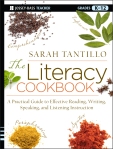 They say a picture is worth a thousand words. They should also add, “And it’s a great way for students to practice comprehension skills, build background knowledge, and become inspired through inquiry.” If you’re looking for a simple, straightforward, fun way to introduce new material, you should try Quadrant Analysis.
They say a picture is worth a thousand words. They should also add, “And it’s a great way for students to practice comprehension skills, build background knowledge, and become inspired through inquiry.” If you’re looking for a simple, straightforward, fun way to introduce new material, you should try Quadrant Analysis.
Here’s how it works:
1) Find a compelling image—a photograph, a reproduction of a painting, or really anything (A math teacher told me she was going to try this with graphs. Why not?). Ideally it should relate to new content that you want to introduce. For example, if you’re about to launch a unit on Civil Rights, you could use a photograph of Dr. Martin Luther King, Jr. speaking to a massive crowd in front of the Washington Monument.
2) The first time you do this process, of course, you need to model it. First: set it up. Begin by drawing a giant “plus” sign on the projected image to divide it into four even quadrants. Number the quadrants 1-4, beginning with the top left and moving clockwise, so you can later refer to “Quadrant 1” or “Quadrant 2” etc. when discussing parts of the image. On a separate blank space nearby (where students can see your notes), draw another quadrant and number it the same way. You will use this space to take notes. Your students should have a copy of the image on a handout, with the bottom half of the page blank, and, if it is not already the norm in your classroom, direct them to imitate your note-taking.[1]
3) Then, starting with Quadrant 1, complete the following steps:
- STEP #1: Describe what you see. In other words, paraphrase what you see.
- STEP# 2: Ask questions about what you see.
- STEP #3: Draw inferences or speculate about what you see.
4) For Quadrant 2, invite students to help you with the three steps.
5) For Quadrant 3, have them complete the steps with a partner then share out with the class.
6) For Quadrant 4, have them complete the steps individually then share out.
7) Along the way, be sure to point out that artists make purposeful decisions about layout, color, shading, size, facial expressions, and so on. And visual metaphors can be as powerful as linguistic ones. Note the focal point(s), and compare how things appear, for example, “above the fold” as opposed to below it (PS—You may have to explain this expression as students who read their newspapers online might not be familiar with the term).
8) Finally, ask students to write a sentence stating what message(s) they think the artist was trying to convey. In other words, what is the main idea or argument? They should be prepared to defend their arguments with evidence.
I love Quadrant Analysis because it is such an easy way to strengthen comprehension skills and get students excited about a new topic. It makes the “text” readily accessible to everyone, and students invariably raise lots of questions and become more curious about the content—often to the point of wanting to do independent research! Your next step can be to say, “Well, as a matter of fact, I happen to have a few answers to your questions right here,” as you distribute an article on the topic.
[1] Doug Lemov calls this technique “Board=Paper.” See Teach Like a Champion: 49 Techniques That Put Students on the Path to College (San Francisco: Jossey-Bass, 2010), 82-84.

Pingback: My Homepage
Have used Sarah’s strategy with much success. By using this process student responses were more thoughtful and developed. I learned so much through my students’s comments during a quadrant analysis of Puritan art– amazing and very powerful strategy for analyzing art.
Thanks, Allison!
Pingback: Essential Literacy Work Before You Begin Test Prep | The Literacy Cookbook blog
Pingback: CLOSE READING STRATEGIES: Nonfiction Edition | The Literacy Cookbook blog
Pingback: CLOSE READING STRATEGIES: Literature Edition | The Literacy Cookbook blog